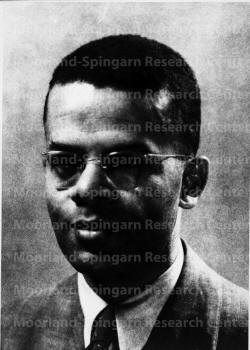

Queer Places:
Columbia University (Ivy League), 116th St and Broadway, New York, NY 10027
Harvard University (Ivy League), 2 Kirkland St, Cambridge, MA 02138
315 W 139th St, New York, NY 10030

Carrington was also a friend of Locke’s partner, Maurice Victor Russell. According to Genny Beemyn, author of A Queer Capital: A History of Gay Life in Washington, the young Russell was just beginning to acknowledge his “othered” sexuality and both Locke and Carrington offered support, comfort, and literature to aid Russell in his process. Beemyn writes, “The ties between Locke, Russell, and Carrington serve as another example of the close circle of gay and bisexual men which centered around Locke.”
Born in Richmond, Virginia on May 7, 1904 to Frances "Fannie" and David Carrington, he was the eldest of four children. He completed his secondary education at Wayland's, a high school department at Virginia Union University, graduating in 1921, and enrolled in Howard University the same year. As a student at Howard, Carrington developed a close friendship with his teacher and mentor Alain Locke, professor of philosophy and “godfather” of the Harlem Renaissance. It was probably through his association with Locke that Carrington developed his love of books and decided to build his library.
During his student career, Carrington was actively involved in extra-curricular activities. He was the editor-in-chief of the school's newspaper and vice president of the student council. While at Howard he became interested in social work as a career and volunteered at the Children's Temporary Home School in Anacostia, Washington, D. C. His interest in social work increased during his senior year when he sought and received a National Urban League fellowship to the School of Social Work, a graduate school of Columbia University in New York City. In 1925 Carrington received his undergraduate degree from Howard University. After graduating he travelled to Europe and the Soviet Union for two years.
Upon his return to the states Carrington worked for a few months for the Raleigh, North Carolina Public Welfare Department. His interest in social work apparently waned for a brief period and he enrolled in graduate school at Harvard majoring in anthropology. Before completion of his studies at Harvard, however, he left to accept employment as a reporter and feature writer for the New York Amsterdam Newsfor six months in 1930.
In the 1930s and 1940s Carrington worked primarily as a parole officer and was one of the first African-Americans to work in that capacity for New York State. During this period he also pursued advanced degrees and earned a Master's in Social Work in 1941 and a Master's in Political Science in the late 1940s, both from Columbia University. With his advanced degree in social work Carrington later moved into the field of psychiatric social work, and worked with the Bureau of Child Guidance, Harlem Hospital and Morrisania Hospital. In addition, from 1969 to 1971 he was a part-time instructor at the Cooperative College Center at the State University of New York specializing in black history.
Carrington developed a love of books primarily documenting the black experience. Among the works Carrington collected were those by Alexander Pushkin, the Russian-born author whose grandfather was an African. Carrington also collected books on the Italian and Harlem Renaissance, African art, and major black authors of the twentieth century such as W.E.B. DuBois, Langston Hughes and Zora Neale Hurston.
Carrington maintained several lifelong friendships, including Ophelia Settles Egypt, a fellow student at Howard University; Henry Wadsworth Longfellow Dana, grandson of Henry Wadsworth Longfellow; and Georgia Douglas Johnson, poet and author.
Glenn Carrington died June 12, 1975.
My published books: